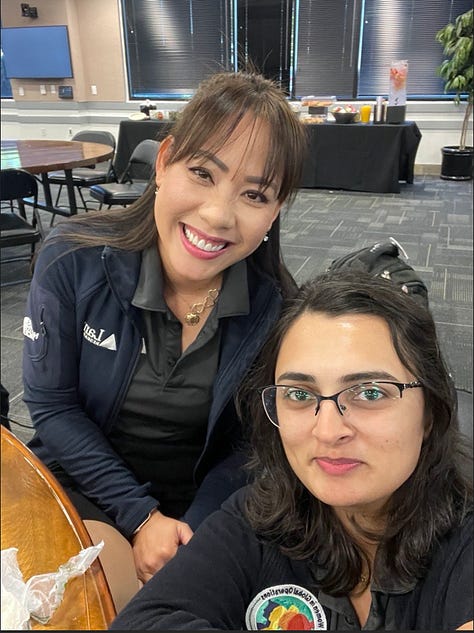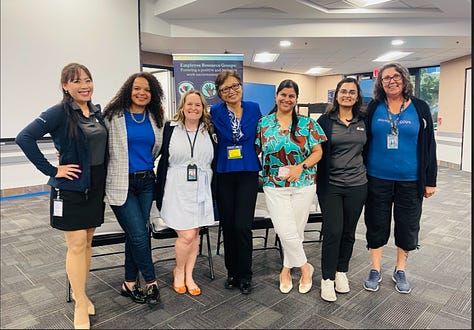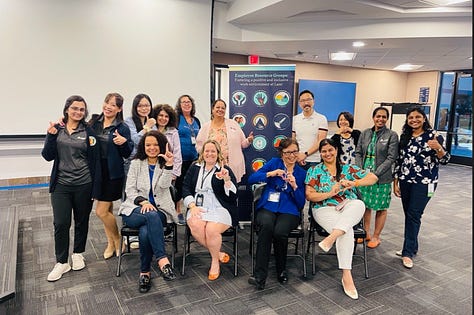Meeting in Person!






I’m one of those people who felt pretty comfortable running meetings and connecting online at events and also one-on-one virtually, even if they are people I didn’t already meet in person.
And of course I knew that connecting with someone in person was far superior, so made the commitment to transition back to on-site events starting in 2025.
When I piloted on-site programs on August 1, I found that the in-person experience was indeed far superior in specific ways.
Reading the much larger amount of emotional cues from real-life people helps everyone to more deeply and readily open up and connect.
Sharing energy and positivity is infectious, especially when it’s done in person.
Tackling real-life operational hurdles is easier when we can all see and experience a problem and address it together.
Meeting in person helps us lean in better and deeper together, making it easier to brainstorm what’s possible.
Connecting in person helps us to look not just at what we’re experiencing today, but also to look forward to what we will do next tomorrow.
We look forward to connecting with you in-person and also online!
A Goldilocks Approach to Growth
Starting and growing a business is not for the faint of heart. Rare is the entrepreneur who can navigate the rapidly shifting market and technology trends to deliver and scale a solution which is well received, profitable and sustainable.
Yet people who are resilient, resourceful, remarkable and lucky continue to launch, expand, and grow. A key to success is choosing to grow - the up-sides - while respecting the guardrails - the limitations - around that growth.
In today’s environment of rapid change, choosing to grow is a foundational part of running a business. We all know the age-old story of Goldilocks and the Three Bears. This is a story of how Goldilocks might approach growing a technology company.
Goldilocks was not satisfied staying in the forest living her very safe and predictable life. She ventured out and discovered a house in the woods. She tried out chairs, porridges, and mattresses and found what worked for her and what didn’t.
She was surprised by the house owners and learned from that adventure.
Goldilocks chose to grow, and learned how to do it in a way that’s not too much, and not too little. If Goldilocks were a tech entrepreneur, these might be her ten growth principles, the rationale for adopting them, and advice on how to grow in a way that’s not too much, not too little.
Choose to Grow and adapt to the times, for with growth comes opportunities, along with the challenges.
Too much growth too fast or in the wrong direction can set you back.
Too little growth too slowly may leave you behind, missing inflection points and market opportunities.
Create a people-first kind of Culture Your people are the ultimate difference-makers.
Too much ‘culture’ may mean insufficient consequences for poor performance or inappropriate behavior, which could lead to a very bad culture.
Too little ‘culture’ may reward and perpetuate leadership and management habits which disengage and disempower and ultimately drive away your most valued employees.
Focus on the needs of your Customers, because serving their needs is the reason you’re in business.
Too much focus on the customer may lead to adopting projects which are unprofitable or unexceptional, or projects which are misaligned with corporate mission and strategy.
Too little focus on customers may lead to producing solutions which don’t meet market and customer needs.
Align with the Purpose - the difference you’ll make for your customers.
Too much alignment to purpose may lead to change-the-world solutions which nobody buys, or which nobody can afford.
Too little alignment on purpose and the company may overstretch resources and muddy the focus and productivity, or confuse the brand and the partners.
Be Strategic with your planning because tracking and responding to market and technology trends will keep you relevant.
Too much strategic planning may delay making decisions and taking action.
Too little strategic planning may lead to drawing poor conclusions, or making bad decisions.
Commit to delivering Exceptional products and services to earn the trust and the business of your customers as well as the respect of the stakeholders.
Too much commitment to excellence may lead to poor profits and delays in completions and deliveries.
Too little commitment to excellence may damage your relationships with customers, and also damage your brand and your reputation.
Leverage Technology to efficiently deliver customized solutions, for it will help the company to deliver excellence with speed and at scale.
Too much technology adoption may lead to an overdependence on complicated or outdated solutions and processes which may delay deliveries and frustrate staff and partners.
Too little technology adoption may lead to an over-dependence on a wide range of manual processes which may depend on too many unmanageable variables.
Boldly Plan for the future, because keeping an eye on both the current and anticipated future needs of the customers will serve you both well.
Too much forward-thinking and bold planning and we may not be able to meet the current needs of our customers.
Too little future-forward bold planning and we could be the followers to a solution which has become commoditized or we could be inefficient in creating a scalable, modular solution.
Grow a Network of trusted partners. Together we are better.
Too much reliance on a network could make it difficult to manage a customer experience.
Too little reliance on a network of trusted partners and we may wind up providing a wide range of services which may be outside our expertise.
Align the way you think, speak and act about the growth plan because aligning with corporate goals and compliance requirements will help fuel growth.
Too much thinking and speaking without action makes the words sound hollow.
Too little thinking and speaking before acting could result in strategic gaffs, planning fiascos, and execution failures.
If you’re like Goldilocks and don’t want to settle for the standard bed, the mainstream porridge, the ordinary chair, consider adopting some Goldilocks principles for growth, and explore what it means to have a dosage of growth that is “juuust right” for your company.
Notes from last month’s Front Line Managers Online and On-Site Program
FountainBlue's August 1 Front Line Managers Online program was on the topic of 'Negotiating for a Win-Win', and was conducted both on-site and online at our Lam Research host location. Please join me in thanking our panelists.
as a Program Leader – Nancy Gilbert, Director of Program Management, Lam Research
as a Product Leader - Ronald Goossens, Part-time Consultant at ASML and Adjunct Professor at Purdue
as an Engineering Leader - Kavita Shah, Vice President, Process Technology, SunRise Memory Corp.
with introduction by Wendy Wright, Project and Program Manager, Lam Research
We deeply appreciate your flexibility and support as we navigated our first on-site *and* online session since March 2020, with the emergence of the pandemic.
We were fortunate to have a diverse, passionate and experienced set of panelists representing a wide range of backgrounds and challenges. They were exceptional in the way they navigated complex challenges, communicated and connected with a wide range of stakeholders, and inspired, motivated and instructed us all to seek the negotiation win-win with perseverance, creativity, resourcefulness and grace.
Below are some thoughts about negotiations:
Negotiation is not just for those who are in business and sales, it's for everyone.
Building strong relationships is foundational for successful negotiations. Plan to create a win-win negotiation so that you can further build on those relationships.
There are many things to negotiate beyond money - there are resources, project participation, benefits, shift times, etc.,
Below is a compilation of their suggested best practices.
Be Strategic
When possible, aim for a win-for-all where possible, working with trusted partners with shared interest, acting with integrity, demonstrating good will.
Align with the strategic direction of the organization, the values of the organization, the shared motivations of the stakeholders.
Gain a wide breadth of knowledge and experience so that you are well informed and connected when participating in a negotiation.
Know the anchoring points for the negotiating parties and then find the joint road map based on those anchoring points.
Be creative and resourceful with your negotiation strategy. For example, if you don't have the data, try extrapolating other data or using an inspirational story, or leveraging an executive contact.
Navigate the guardrails between what the science will allow and what the business can resource/support as you negotiate.
Understand and work within the risk appetite for your organization, especially as you work on cutting edge/bleeding edge projects.
If the negotiated result is failing, fail fast and learn from it and proactively communicate the shifts and the learnings.
Leverage Your Network
Create and build a broad and deep network of relationships, an ecosystem of trusted stakeholders and continue to collaborate, delivering win-win results for all parties.
Share your negotiation successes and learnings with your network as they may set you up for the next successful negotiation.
Know when to escalate, leveraging your network, talking to stakeholders who are not currently at the table to break a logjam for example.
Know Your Stakeholders
Know the assumptions and motivations of the stakeholders.
Build in optionality in your proposals, with an eye on the motivations of your various stakeholders.
Listen attentively to what's said and what's not said, but what's meant.
Ask questions out of curiosity and make sure that everyone feels heard.
Plan and Manage the Negotiations Well
Focus on getting the metrics, but avoid analysis paralysis, where you're waiting for too much data to proceed and delay making an agreement or decision.
Know your walking point, your non-negotiables - the point where you decide for specific reasons *not* to continue with a negotiation. With that said, make efforts to maintain the relationships.
The greatest learning for me was that negotiation is more an interactive, multi-dimensional give and take, a respectful exchange of ideas and strategies rather than a simple one-dimensional formula.
The best negotiators, like the ones on our panel, are people who are experienced, have high-integrity, and are strategists and problem-solvers who are invested in the success of all stakeholders involved.
We are grateful that they shared their wisdom with us for this program.
Notes from last month’s When She Speaks Online Program
FountainBlue's August 8 When She Speaks online program was on the topic of 'What He / She Said, What She / He Meant'. Please join me in thanking our esteemed panelists.
Facilitator Linda Holroyd, CEO, FountainBlue LLC
Panelist Sanchita Gupta, Senior Director, Human Resources Business Partner, Samsung Research America
Panelist Eunice Kim, General Counsel, Securonix
Panelist Nehal Mehta, Director Global Strategic Alliances, Genesys
Panelist Susan Norton, Senior Director, Human Resources, BOLD
We were fortunate to have such a dynamic and diverse panel of leaders who were bold and open as they spoke on this afternoon's topic. They have much in common:
They 'did their homework' to make sure that they are educated and qualified enough to take on their ever-expanding roles and responsibilities.
They each embraced a combination of proactively planning their career and opportunities and accepting and embracing the opportunities which arose for them.
They focused on building relationships and refining communications with a wide breadth of stakeholders, independent of gender, role, industry, and level.
Below is a compilation of advice and thoughts on how we can each improve our executive presence, so that we are heard and respected, independent of our gender.
Be a team player, but also be fully present and engaged, showing up fully, regardless of your current title and role.
Speak concisely, logically and honestly, with the intent of building bridges and delivering bottom line results.
It's not necessary to raise your voice to be heard, but it *is* necessary to have a clear and well-stated, fact-based message.
Gently and respectfully call out someone when necessary and appropriate, to defend your rights, your feelings, your position, your project, your colleagues, your company etc.,
Choose to sit at the table where appropriate, and if you're prepared. There may even be an opportunity to 'own the meeting', to help ensure that the meeting is productive and worthwhile.
Below is a compilation of advice provided when poor communications negatively impact the team/company's efficiency, productivity, and culture.
Bring people together.
Build relationships and connections of trust and focus on helping people to work together to deliver end results.
Be sympathetic and supportive – aware of people’s sensitivities and needs.
Connect and help others, and help others to do the same.
Assume a role and level which will allow you to contribute.
Create/claim/insist on a seat at the table.
Rather than making the coffee or organizing the logistics, try delegating tasks or using tools so that you get to be part of the decision-making and planning process.
Step in and Step up once you have a seat at the table.
Practice creative and collaborative problem solving, based on facts, and deliver results.
Become known for being thorough, knowing your stuff inside out.
Don’t be afraid to speak up and ask questions – be interested, curious and engaged.
Be a patient listener, don’t have pre-formed fixed opinions.
Demonstrate your understanding of even complex concepts with the words you speak, the actions you take.
The bottom line is that we are all different, but communicating with honesty, integrity, directness, and empathy will help us all be more strategic, more collaborative, and more likely to get things done, regardless of our gender.
Notes from last month’s VIP Roundtable Online Program
FountainBlue's August 9 VIP roundtable was on the topic of 'AR/VR Enterprise Solutions'. We were fortunate to have such passionate, diverse and experienced executives in attendance, speaking to the opportunities and challenges of providing enterprise use cases for AR/VR.
Some of them have been in the industry for decades, witnessing the rapid development and expansion of technologies - from hardware to software from networking to drones - and markets - from the early adopters and gamers to consumer-led adoption and now enterprise solutions.
Others are applying AR/VR capabilities to industries less known for being early adopters of technology.
But they share common perspectives about the benefits of leveraging AR/VR for creating immersive experiences.
Participating in a realistic and immersive experience helps people feel more engaged and connected.
It will not necessarily eliminate the need for in-person, in-real-life experiences, but it could supplement and enrich them.
It does not necessarily follow that experiencing something virtually will lead to in-person experience, but it will allow more people to experience something even if it's only virtually, and it will help others to decide whether to participate in the same experience in-person, or which of several experiences would work best for them.
It's clear that providing realistic simulations provides a slew of enterprise use cases.
Design and Prototyping - Digital simulations are much more realistic now and provide great value in effectively supporting the designing and prototyping for new products and features.
Training and Simulations - Immersive AR/VR experiences can support training requirements much like simulations from drivers education courses help train drivers.
Diagnostics and Optimization - AR/VR solutions can be used to collect diagnostic data on equipment and optimize the usage and maintenance of the equipment.
Retail and Sales - Immersive digital experiences can help users evaluate how well furniture or appliances might fit in your space or how good you would look in a pair of pants or shoes.
Scenario Planning - Digital experiences can support scenario planning, saving time and resources and informing strategies and decisions to be implemented in real life.
Remote Support - Virtual experiences of the real-life needs of people on the battlefield or on a manufacturing floor for example can help experts provide real-time, critical technical support.
Digital Twinning -
Augmented Reality can overlay a digital twin onto a physical machine to provide additional information for training, maintenance, support, purposes for example.
VR can simulate various scenarios within the digital twin environment - for example having a digital twin of a specific airplane can help understand the past and current and projected future data and plan for maintenance or optimize for safety.
Below is a compiled list of opportunities mentioned by our executives:
Consider providing virtual operation of heavy equipment - teleoperation
The technology is evolving enough that we can begin integrating 'real world' videos and audios rather than using digital graphics makes the experience more realistic and immersive.
Leverage gaming solution technology to deliver immersive and realistic experiences - think simulated driving in rural terrains or on a racetrack.
Integrate AI and ML technologies with AR/VR solutions to provide real-world value for your customers.
As the line between the digital and the physical begins to further blur, our executives in attendance agree that we are on the cusp of embracing groundbreaking AR/VR solutions which will drive business growth and create value for a broad range of stakeholders in the real world.









